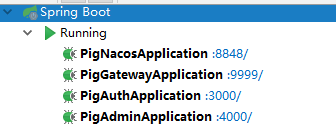pig版本: 3.5.2
是否修改包名: 否
当前pig-auth认证服务器的访问令牌端点为/oauth2/token,用户登出的接口路径为/token/logout,我想自定义这两个路径,请问有什么思路?
另外我希望刷新token的路径和其他几种登录模式的路径不相同,并且在请求刷新token接口时可以不用携带grant_type=refresh_token这个参数,有什么思路?是否一定要重写类替代源码中的OAuth2TokenEndpointFilter类?


此处可能存在不合适展示的内容,页面不予展示。您可通过相关编辑功能自查并修改。
如您确认内容无涉及 不当用语 / 纯广告导流 / 暴力 / 低俗色情 / 侵权 / 盗版 / 虚假 / 无价值内容或违法国家有关法律法规的内容,可点击提交进行申诉,我们将尽快为您处理。
或许你可以参考这个项目的思路:
https://gitee.com/xuxiaowei-com-cn/spring-boot-starter-wechat-miniprogram
项目的主要功能是实现了微信小程序使用 OAuth 2.1 授权登录返回 JWT JSON Token。
自定义授权类型 grant_type 为 wechat_miniprogram,微信小程序登录时,只有授权码 code,微信小程序的 appid 可以从请求头中的 Referer 中截取。响应 JWT JSON Token。
自定义修改 /oauth2/token:
!261::sparkles: 自定义修改 /oauth2/token、自定义刷新Token,不用携带参数 grant_type=refresh_token
/token/logout 是用户退出路径,手动删除 Token:
https://gitee.com/log4j/pig/blob/master/pig-auth/src/main/java/com/pig4cloud/pig/auth/endpoint/PigTokenEndpoint.java#L126
请检查上述两个问题是否正确。
最后一个问题正在看:

我找到了刷新Token的核心代码:org.springframework.security.oauth2.server.authorization.authentication.OAuth2RefreshTokenAuthenticationProvider
可以考虑将核心代码拿出来,自己写一个Controller,这样一来就无需改变原有项目架构,可高度自定义。
/*
* Copyright 2020-2022 the original author or authors.
*
* Licensed under the Apache License, Version 2.0 (the "License");
* you may not use this file except in compliance with the License.
* You may obtain a copy of the License at
*
* https://www.apache.org/licenses/LICENSE-2.0
*
* Unless required by applicable law or agreed to in writing, software
* distributed under the License is distributed on an "AS IS" BASIS,
* WITHOUT WARRANTIES OR CONDITIONS OF ANY KIND, either express or implied.
* See the License for the specific language governing permissions and
* limitations under the License.
*/
package org.springframework.security.oauth2.server.authorization.authentication;
import java.security.Principal;
import java.util.Collections;
import java.util.HashMap;
import java.util.Map;
import java.util.Set;
import org.springframework.security.authentication.AuthenticationProvider;
import org.springframework.security.core.Authentication;
import org.springframework.security.core.AuthenticationException;
import org.springframework.security.oauth2.core.AuthorizationGrantType;
import org.springframework.security.oauth2.core.ClaimAccessor;
import org.springframework.security.oauth2.core.OAuth2AccessToken;
import org.springframework.security.oauth2.core.OAuth2AuthenticationException;
import org.springframework.security.oauth2.core.OAuth2Error;
import org.springframework.security.oauth2.core.OAuth2ErrorCodes;
import org.springframework.security.oauth2.core.OAuth2RefreshToken;
import org.springframework.security.oauth2.core.OAuth2Token;
import org.springframework.security.oauth2.core.oidc.OidcIdToken;
import org.springframework.security.oauth2.core.oidc.OidcScopes;
import org.springframework.security.oauth2.core.oidc.endpoint.OidcParameterNames;
import org.springframework.security.oauth2.jwt.Jwt;
import org.springframework.security.oauth2.server.authorization.OAuth2Authorization;
import org.springframework.security.oauth2.server.authorization.OAuth2AuthorizationService;
import org.springframework.security.oauth2.server.authorization.OAuth2TokenType;
import org.springframework.security.oauth2.server.authorization.client.RegisteredClient;
import org.springframework.security.oauth2.server.authorization.context.ProviderContextHolder;
import org.springframework.security.oauth2.server.authorization.token.DefaultOAuth2TokenContext;
import org.springframework.security.oauth2.server.authorization.token.OAuth2TokenContext;
import org.springframework.security.oauth2.server.authorization.token.OAuth2TokenGenerator;
import org.springframework.util.Assert;
import static org.springframework.security.oauth2.server.authorization.authentication.OAuth2AuthenticationProviderUtils.getAuthenticatedClientElseThrowInvalidClient;
/**
* An {@link AuthenticationProvider} implementation for the OAuth 2.0 Refresh Token Grant.
*
* @author Alexey Nesterov
* @author Joe Grandja
* @author Anoop Garlapati
* @since 0.0.3
* @see OAuth2RefreshTokenAuthenticationToken
* @see OAuth2AccessTokenAuthenticationToken
* @see OAuth2AuthorizationService
* @see OAuth2TokenGenerator
* @see <a target="_blank" href="https://datatracker.ietf.org/doc/html/rfc6749#section-1.5">Section 1.5 Refresh Token Grant</a>
* @see <a target="_blank" href="https://datatracker.ietf.org/doc/html/rfc6749#section-6">Section 6 Refreshing an Access Token</a>
*/
public final class OAuth2RefreshTokenAuthenticationProvider implements AuthenticationProvider {
private static final String ERROR_URI = "https://datatracker.ietf.org/doc/html/rfc6749#section-5.2";
private static final OAuth2TokenType ID_TOKEN_TOKEN_TYPE = new OAuth2TokenType(OidcParameterNames.ID_TOKEN);
private final OAuth2AuthorizationService authorizationService;
private final OAuth2TokenGenerator<? extends OAuth2Token> tokenGenerator;
/**
* Constructs an {@code OAuth2RefreshTokenAuthenticationProvider} using the provided parameters.
*
* @param authorizationService the authorization service
* @param tokenGenerator the token generator
* @since 0.2.3
*/
public OAuth2RefreshTokenAuthenticationProvider(OAuth2AuthorizationService authorizationService,
OAuth2TokenGenerator<? extends OAuth2Token> tokenGenerator) {
Assert.notNull(authorizationService, "authorizationService cannot be null");
Assert.notNull(tokenGenerator, "tokenGenerator cannot be null");
this.authorizationService = authorizationService;
this.tokenGenerator = tokenGenerator;
}
@Override
public Authentication authenticate(Authentication authentication) throws AuthenticationException {
OAuth2RefreshTokenAuthenticationToken refreshTokenAuthentication =
(OAuth2RefreshTokenAuthenticationToken) authentication;
OAuth2ClientAuthenticationToken clientPrincipal =
getAuthenticatedClientElseThrowInvalidClient(refreshTokenAuthentication);
RegisteredClient registeredClient = clientPrincipal.getRegisteredClient();
OAuth2Authorization authorization = this.authorizationService.findByToken(
refreshTokenAuthentication.getRefreshToken(), OAuth2TokenType.REFRESH_TOKEN);
if (authorization == null) {
throw new OAuth2AuthenticationException(OAuth2ErrorCodes.INVALID_GRANT);
}
if (!registeredClient.getId().equals(authorization.getRegisteredClientId())) {
throw new OAuth2AuthenticationException(OAuth2ErrorCodes.INVALID_CLIENT);
}
if (!registeredClient.getAuthorizationGrantTypes().contains(AuthorizationGrantType.REFRESH_TOKEN)) {
throw new OAuth2AuthenticationException(OAuth2ErrorCodes.UNAUTHORIZED_CLIENT);
}
OAuth2Authorization.Token<OAuth2RefreshToken> refreshToken = authorization.getRefreshToken();
if (!refreshToken.isActive()) {
// As per https://tools.ietf.org/html/rfc6749#section-5.2
// invalid_grant: The provided authorization grant (e.g., authorization code,
// resource owner credentials) or refresh token is invalid, expired, revoked [...].
throw new OAuth2AuthenticationException(OAuth2ErrorCodes.INVALID_GRANT);
}
// As per https://tools.ietf.org/html/rfc6749#section-6
// The requested scope MUST NOT include any scope not originally granted by the resource owner,
// and if omitted is treated as equal to the scope originally granted by the resource owner.
Set<String> scopes = refreshTokenAuthentication.getScopes();
Set<String> authorizedScopes = authorization.getAuthorizedScopes();
if (!authorizedScopes.containsAll(scopes)) {
throw new OAuth2AuthenticationException(OAuth2ErrorCodes.INVALID_SCOPE);
}
if (scopes.isEmpty()) {
scopes = authorizedScopes;
}
// @formatter:off
DefaultOAuth2TokenContext.Builder tokenContextBuilder = DefaultOAuth2TokenContext.builder()
.registeredClient(registeredClient)
.principal(authorization.getAttribute(Principal.class.getName()))
.providerContext(ProviderContextHolder.getProviderContext())
.authorization(authorization)
.authorizedScopes(scopes)
.authorizationGrantType(AuthorizationGrantType.REFRESH_TOKEN)
.authorizationGrant(refreshTokenAuthentication);
// @formatter:on
OAuth2Authorization.Builder authorizationBuilder = OAuth2Authorization.from(authorization);
// ----- Access token -----
OAuth2TokenContext tokenContext = tokenContextBuilder.tokenType(OAuth2TokenType.ACCESS_TOKEN).build();
OAuth2Token generatedAccessToken = this.tokenGenerator.generate(tokenContext);
if (generatedAccessToken == null) {
OAuth2Error error = new OAuth2Error(OAuth2ErrorCodes.SERVER_ERROR,
"The token generator failed to generate the access token.", ERROR_URI);
throw new OAuth2AuthenticationException(error);
}
OAuth2AccessToken accessToken = new OAuth2AccessToken(OAuth2AccessToken.TokenType.BEARER,
generatedAccessToken.getTokenValue(), generatedAccessToken.getIssuedAt(),
generatedAccessToken.getExpiresAt(), tokenContext.getAuthorizedScopes());
if (generatedAccessToken instanceof ClaimAccessor) {
authorizationBuilder.token(accessToken, (metadata) -> {
metadata.put(OAuth2Authorization.Token.CLAIMS_METADATA_NAME, ((ClaimAccessor) generatedAccessToken).getClaims());
metadata.put(OAuth2Authorization.Token.INVALIDATED_METADATA_NAME, false);
});
} else {
authorizationBuilder.accessToken(accessToken);
}
// ----- Refresh token -----
OAuth2RefreshToken currentRefreshToken = refreshToken.getToken();
if (!registeredClient.getTokenSettings().isReuseRefreshTokens()) {
tokenContext = tokenContextBuilder.tokenType(OAuth2TokenType.REFRESH_TOKEN).build();
OAuth2Token generatedRefreshToken = this.tokenGenerator.generate(tokenContext);
if (!(generatedRefreshToken instanceof OAuth2RefreshToken)) {
OAuth2Error error = new OAuth2Error(OAuth2ErrorCodes.SERVER_ERROR,
"The token generator failed to generate the refresh token.", ERROR_URI);
throw new OAuth2AuthenticationException(error);
}
currentRefreshToken = (OAuth2RefreshToken) generatedRefreshToken;
authorizationBuilder.refreshToken(currentRefreshToken);
}
// ----- ID token -----
OidcIdToken idToken;
if (authorizedScopes.contains(OidcScopes.OPENID)) {
// @formatter:off
tokenContext = tokenContextBuilder
.tokenType(ID_TOKEN_TOKEN_TYPE)
.authorization(authorizationBuilder.build()) // ID token customizer may need access to the access token and/or refresh token
.build();
// @formatter:on
OAuth2Token generatedIdToken = this.tokenGenerator.generate(tokenContext);
if (!(generatedIdToken instanceof Jwt)) {
OAuth2Error error = new OAuth2Error(OAuth2ErrorCodes.SERVER_ERROR,
"The token generator failed to generate the ID token.", ERROR_URI);
throw new OAuth2AuthenticationException(error);
}
idToken = new OidcIdToken(generatedIdToken.getTokenValue(), generatedIdToken.getIssuedAt(),
generatedIdToken.getExpiresAt(), ((Jwt) generatedIdToken).getClaims());
authorizationBuilder.token(idToken, (metadata) ->
metadata.put(OAuth2Authorization.Token.CLAIMS_METADATA_NAME, idToken.getClaims()));
} else {
idToken = null;
}
authorization = authorizationBuilder.build();
this.authorizationService.save(authorization);
Map<String, Object> additionalParameters = Collections.emptyMap();
if (idToken != null) {
additionalParameters = new HashMap<>();
additionalParameters.put(OidcParameterNames.ID_TOKEN, idToken.getTokenValue());
}
return new OAuth2AccessTokenAuthenticationToken(
registeredClient, clientPrincipal, accessToken, currentRefreshToken, additionalParameters);
}
@Override
public boolean supports(Class<?> authentication) {
return OAuth2RefreshTokenAuthenticationToken.class.isAssignableFrom(authentication);
}
}
我将您提交的代码拉到项目中断点调试,已经实现了当前的需求,但是这样做会存在一个问题:就是原先的"/login"(已经将访问令牌的端点由"/oauth2/token"改为"/login")端点仍然可用,仍然可以用它来刷新token,能否将它禁用,只允许使用新写的这个"/token/refresh"接口来刷新token呢?
如果要禁用原端点的刷新功能,可以参考下列代码中,删除 OAuth2RefreshTokenAuthenticationConverter:
https://gitee.com/xuxiaowei-cloud/xuxiaowei-cloud/blob/main/passport/src/main/java/cloud/xuxiaowei/passport/configuration/AuthorizationServerConfiguration.java
// 自定义客户授权
authorizationServerConfigurer.tokenEndpoint(tokenEndpointCustomizer -> tokenEndpointCustomizer
.accessTokenRequestConverter(new DelegatingAuthenticationConverter(Arrays.asList(
// 新增:微信 OAuth2 用于验证授权授予的 {@link
// OAuth2WeChatMiniProgramAuthenticationToken}
new OAuth2WeChatMiniProgramAuthenticationConverter(),
// 默认值:OAuth2 授权码认证转换器
new OAuth2AuthorizationCodeAuthenticationConverter(),
// 默认值:OAuth2 刷新令牌认证转换器
new OAuth2RefreshTokenAuthenticationConverter(),
// 默认值:OAuth2 客户端凭据身份验证转换器
new OAuth2ClientCredentialsAuthenticationConverter())))
// 用于处理失败的身份验证尝试的策略。
.errorResponseHandler(new AccessTokenAuthenticationFailureHandlerImpl()));
如果没有其他问题,此议题可以关闭了
登录 后才可以发表评论